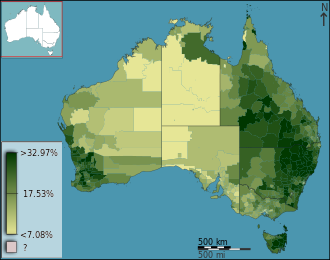Choropleth map





Choropleth map is a type of thematic map used for representing spatial data through various shading patterns or colors in predefined areas. These maps are commonly used to depict density, percentage, or average values of a particular geographic area, making them a valuable tool in geography, statistics, public health, and socio-economic analysis. The term "choropleth" comes from the Greek words "choro" meaning "area" or "region" and "pleth" meaning "a value", thus choropleth map translates to "a map of values over areas".
Overview[edit]
A choropleth map is distinguished by its use of color to represent the intensity or magnitude of a particular attribute, such as population density, poverty rate, or election results, across different regions. The geographic area is usually divided into predefined units like countries, states, counties, or districts. Each unit is then colored or shaded according to the data value it represents, allowing for easy visual comparison across regions.
Construction[edit]
The construction of a choropleth map involves several key steps:
- Data Collection: Gathering accurate and relevant data for the attribute to be mapped.
- Data Classification: Dividing the data into categories or classes. Common classification methods include equal intervals, quantiles, natural breaks (Jenks), and standard deviations.
- Color Selection: Choosing a color scheme that effectively represents the range of data values. Sequential, diverging, and qualitative are the three main types of color schemes used.
- Map Creation: Applying the color scheme to the geographic units based on their data classification.
Uses[edit]
Choropleth maps are widely used in various fields for different purposes:
- In public health, to show the distribution of health-related statistics such as disease incidence or vaccination rates.
- In economics, to illustrate economic indicators like GDP per capita or unemployment rates across different regions.
- In political science, to represent election results, showing which areas voted for which candidate or party.
- In environmental science, to display data on climate variables, pollution levels, or land use patterns.
Advantages and Limitations[edit]
Advantages:
- Choropleth maps are relatively easy to understand, making them accessible to a broad audience.
- They are effective for showing the geographical distribution of data and identifying patterns or trends across different regions.
Limitations:
- They can be misleading if the areas of the geographic units vary significantly, as larger areas may appear more important regardless of their actual value.
- The choice of classification method and color scheme can greatly influence the map's interpretation.
- They do not represent data at a point level and are not suitable for showing precise locations of phenomena.
See Also[edit]
Ad. Transform your life with W8MD's Budget GLP-1 injections from $75


W8MD offers a medical weight loss program to lose weight in Philadelphia. Our physician-supervised medical weight loss provides:
- Weight loss injections in NYC (generic and brand names):
- Zepbound / Mounjaro, Wegovy / Ozempic, Saxenda
- Most insurances accepted or discounted self-pay rates. We will obtain insurance prior authorizations if needed.
- Generic GLP1 weight loss injections from $75 for the starting dose.
- Also offer prescription weight loss medications including Phentermine, Qsymia, Diethylpropion, Contrave etc.
NYC weight loss doctor appointmentsNYC weight loss doctor appointments
Start your NYC weight loss journey today at our NYC medical weight loss and Philadelphia medical weight loss clinics.
- Call 718-946-5500 to lose weight in NYC or for medical weight loss in Philadelphia 215-676-2334.
- Tags:NYC medical weight loss, Philadelphia lose weight Zepbound NYC, Budget GLP1 weight loss injections, Wegovy Philadelphia, Wegovy NYC, Philadelphia medical weight loss, Brookly weight loss and Wegovy NYC
|
WikiMD's Wellness Encyclopedia |
| Let Food Be Thy Medicine Medicine Thy Food - Hippocrates |
Medical Disclaimer: WikiMD is not a substitute for professional medical advice. The information on WikiMD is provided as an information resource only, may be incorrect, outdated or misleading, and is not to be used or relied on for any diagnostic or treatment purposes. Please consult your health care provider before making any healthcare decisions or for guidance about a specific medical condition. WikiMD expressly disclaims responsibility, and shall have no liability, for any damages, loss, injury, or liability whatsoever suffered as a result of your reliance on the information contained in this site. By visiting this site you agree to the foregoing terms and conditions, which may from time to time be changed or supplemented by WikiMD. If you do not agree to the foregoing terms and conditions, you should not enter or use this site. See full disclaimer.
Credits:Most images are courtesy of Wikimedia commons, and templates, categories Wikipedia, licensed under CC BY SA or similar.
Translate this page: - East Asian
中文,
日本,
한국어,
South Asian
हिन्दी,
தமிழ்,
తెలుగు,
Urdu,
ಕನ್ನಡ,
Southeast Asian
Indonesian,
Vietnamese,
Thai,
မြန်မာဘာသာ,
বাংলা
European
español,
Deutsch,
français,
Greek,
português do Brasil,
polski,
română,
русский,
Nederlands,
norsk,
svenska,
suomi,
Italian
Middle Eastern & African
عربى,
Turkish,
Persian,
Hebrew,
Afrikaans,
isiZulu,
Kiswahili,
Other
Bulgarian,
Hungarian,
Czech,
Swedish,
മലയാളം,
मराठी,
ਪੰਜਾਬੀ,
ગુજરાતી,
Portuguese,
Ukrainian
